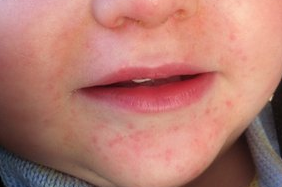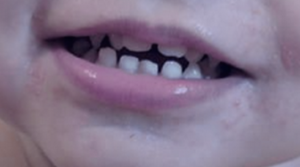Drool rash refers to a rash that forms around the cheeks and mouth, on the chest, and in the creases of the neck in a baby due to wet skin caused by presence of excess amounts of saliva on skin for prolonged periods.
Drooling is usually a side effect of teething, but it can occur even the babies are not teething. The salivary glands of a baby begin functioning between ages of 2 and 3 months. This can result in drooling, even though teething has not occurred. The continuous presence of saliva on the neck, chin, chest, cheeks, and mouth of the baby irritates the skin, thereby leading to formation of reddish drool rash.
Besides drooling, use of a pacifier which ensures that the area around the mouth remains wet, can also cause drool rash. Also, the rash may also form if food is left on the face for a prolonged period.
Symptoms
The symptoms of drool rash are:
- Drool rash is usually made up of flattened or somewhat raised skin patches along with reddish bumps.
- The rash may also appear to be chapped.
- The rash generally occurs around the mouth and on the cheeks, chest, chin, and folds of the neck.
Drool rash is a mild condition and typically heals with home treatments. Parents may however consult a pediatrician in the following cases:
- If the rash shows drainage or is cracked
- If the rash causes pain to the baby
- If the rash does not show improvement even after 7 or more days of home treatment
Drool rash – Treatment
In severe cases, the doctor may prescribe creams which can alleviate discomfort of the baby and promote faster healing.
Mild cases of drool rash can be treated in the following ways:
- Ensure that the baby’s skin is kept clean and dry. This will not only help prevent future cases of drool rash, but will also protect the skin from other kinds of skin infections.
- Gently wash the affected skin areas with warm water, two times a day. Then use a soft clean piece of cloth to pat dry the area. Do not rub as it can irritate the delicate skin of the baby and result in itchiness, redness, and distress for the baby.
- Apply a thin layer of protective hypoallergenic lotion, cream, or ointment on the affected skin. You can use petroleum jelly, or Aquaphor, or other lotions with lanolin as an ingredient. It will not only help soothe the skin but will also act as a barrier between the drool and the baby’s skin.
- Avoid using any harsh products as that can irritate the sensitive skin and further exacerbate the rash. Ensure that protective cream is applied in a thin layer so that the baby does not get it into his mouth or hands.
- Pure coconut oil can also be applied on affected skin as treatment for the rash. The oil has antibacterial properties and can help prevent secondary infections. Coconut oil can also act as a great lubricant and help ease the discomfort and irritation.
Drool Rash – Pictures
Prevention of drool rash and best practices
It is very hard to prevent babies from drooling. Hence, parents can follow the below listed guidelines to prevent drool rash formation.
- Ensure that you have a soft burp cloth suitable for babies handy at all times. Thus, you can wipe away drool whenever it occurs. Frequently wipe the neck creases and face of the baby, particularly during feeding sessions. Keeping the baby’s skin dry and clean is the best remedy for drool rash. Use a gentle dabbing motion to clean the skin dry so as to avoid irritating the delicate skin.
- In case of excessive drooling which causes the shirt or top to get wet, parents may opt for a bib. This will ensure that the wet material does not rub against the skin of the baby. Change the bibs whenever they become wet.
- Get rid of all potential irritants and allergens in the immediate vicinity of the baby who is affected by drool rash. Use fragrance-free laundry detergent to wash the baby’s clothes, bibs, sheets, and burp cloths. The caregiver may also choose to wash his/her clothes with the same detergent. Avoid the use of scented lotions or perfumes for the time being as it may hamper the healing process.
- Use an unscented mild baby wash when giving baths to the baby. If the baby has dry skin, then you may use an unscented gentle lotion if required. Parents however need to make sure that the lotion is not used on the drool rash.
- In case teething is causing increased drooling, then offer something cold to the baby for his/her gums. Do not offer frozen items. You may also try a cold washcloth or a teething ring. It will provide a cool numbing sensation to the sore gums of the baby as well to any rash that has formed around the mouth.

